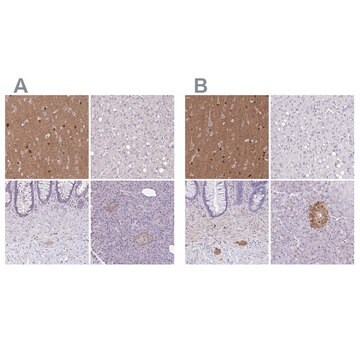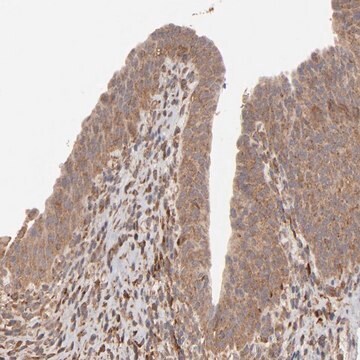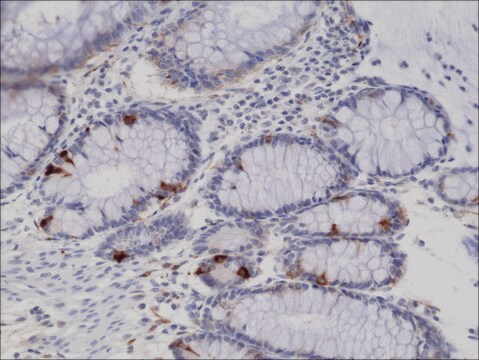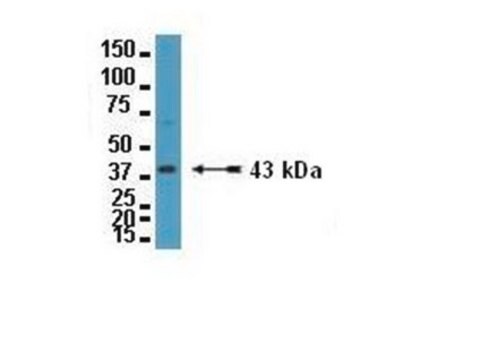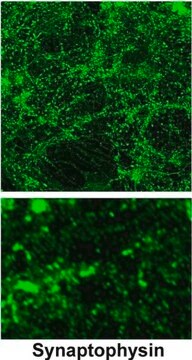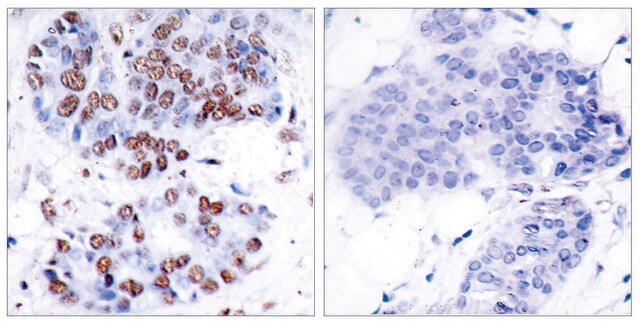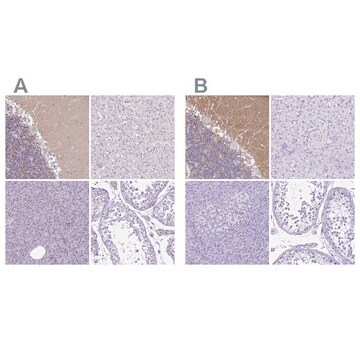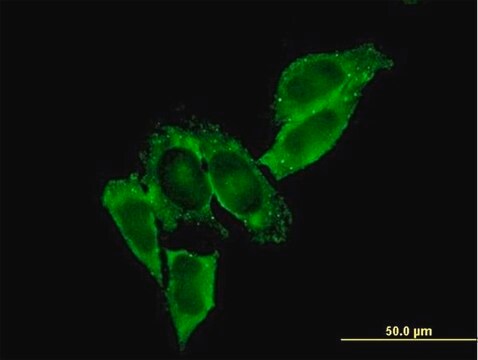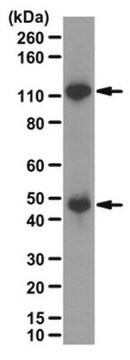おすすめの製品
由来生物
mouse
品質水準
抗体製品の状態
purified immunoglobulin
抗体製品タイプ
primary antibodies
クローン
10C11.1, monoclonal
化学種の反応性
human, mouse
テクニック
immunohistochemistry: suitable (paraffin)
western blot: suitable
アイソタイプ
IgG1κ
NCBIアクセッション番号
UniProtアクセッション番号
輸送温度
wet ice
ターゲットの翻訳後修飾
unmodified
遺伝子情報
human ... SYT4(6860)
詳細
Synaptotagmin-4 (UniProt Q9H2B2; also known as Synaptotagmin IV, SytIV) is encoded by the SYT4 (also known as KIAA1342) gene (Gene ID 6860) in human. The mammalian synaptotagmin family is comprised of 17 members. While most of them are predominantly function in the cetnral nervous system (CNS), some are involved in the vesicular functions of endocrine cells and glucose-transport metabolic cells. Synaptotagmin-4 is an inducible member detectable only in the brain and the neuroendocrine system. Unlike other family members, synaptotagmin-4 does not bind calcium and does not medidate calcium-induced exocytosis. Instead, synaptotagmin-4 is shown to play a neuroendocrine role in inhibiting exocytotic activities in the posterior pituitary and in cultured PC12 cells. Synaptotagmin-4 is expressed most abundantly in oxytocin neurons of the hypothalamus, where it negatively regulates oxytocin exocytosis. Dietary obesity is associated with increased vesicle binding of synaptotagmin-4 and decreased oxytocin release. Normalizing oxytocin release via Synaptotagmin-4 inhibition prevents against dietary obesity under chronic nutritional excess. Human synaptotagmin-4 consists of a vesiclular domain (a.a. 1-16), a transmembrane segment (a.a. 17-37),and a large cytoplasmic domain (a.a. 38-425).
特異性
Clone 10C11.1 targets a cytoplasmic epitope present in both human spliced isoforms reported by UniProt (Q9H2B2).
免疫原
Epitope: Cytoplasmic domain.
GST-tagged recombinant human Synaptotagmin-4 cytoplasmic domain fragment.
アプリケーション
Research Category
ニューロサイエンス
ニューロサイエンス
Research Sub Category
小胞輸送
小胞輸送
Immunohistochemistry Analysis: A 1:50 dilution from a representative lot detected Synaptotagmin-4 in human kidney, skeletal muscle, and pancreas tissue sections.
This Anti-Synaptotagmin-4 Antibody, clone 10C11.1 is validated for use in Western Blotting, Immunohistochemistry (Paraffin) for the detection of Synaptotagmin-4.
品質
Evaluated by Western Blotting in mouse cerebellum tissue lysate.
Western Blotting Analysis: 1.0 µg/mL of this antibody detected Synaptotagmin-4 in 10 µg of mouse cerebellum tissue lysate.
Western Blotting Analysis: 1.0 µg/mL of this antibody detected Synaptotagmin-4 in 10 µg of mouse cerebellum tissue lysate.
ターゲットの説明
~48 kDa observed. 47.96/46.06 kDa (human isoform 1/2) and 47.66 kDa (mouse) calculated.
物理的形状
Protein G purified.
Format: Purified
Purified mouse monoclonal IgG1κ antibody in buffer containing 0.1 M Tris-Glycine (pH 7.4), 150 mM NaCl with 0.05% sodium azide.
保管および安定性
Stable for 1 year at 2-8°C from date of receipt.
その他情報
Concentration: Please refer to lot specific datasheet.
免責事項
Unless otherwise stated in our catalog or other company documentation accompanying the product(s), our products are intended for research use only and are not to be used for any other purpose, which includes but is not limited to, unauthorized commercial uses, in vitro diagnostic uses, ex vivo or in vivo therapeutic uses or any type of consumption or application to humans or animals.
適切な製品が見つかりませんか。
製品選択ツール.をお試しください
保管分類コード
12 - Non Combustible Liquids
WGK
WGK 1
適用法令
試験研究用途を考慮した関連法令を主に挙げております。化学物質以外については、一部の情報のみ提供しています。 製品を安全かつ合法的に使用することは、使用者の義務です。最新情報により修正される場合があります。WEBの反映には時間を要することがあるため、適宜SDSをご参照ください。
Jan Code
MABN109:
試験成績書(COA)
製品のロット番号・バッチ番号を入力して、試験成績書(COA) を検索できます。ロット番号・バッチ番号は、製品ラベルに「Lot」または「Batch」に続いて記載されています。
Yazi D Ke et al.
The Journal of biological chemistry, 294(38), 14149-14162 (2019-08-02)
The microtubule-associated protein tau undergoes aberrant modification resulting in insoluble brain deposits in various neurodegenerative diseases, including frontotemporal dementia (FTD), progressive supranuclear palsy, and corticobasal degeneration. Tau aggregates can form in different cell types of the central nervous system (CNS)
ライフサイエンス、有機合成、材料科学、クロマトグラフィー、分析など、あらゆる分野の研究に経験のあるメンバーがおります。.
製品に関するお問い合わせはこちら(テクニカルサービス)
